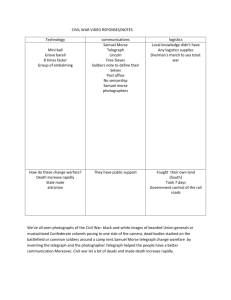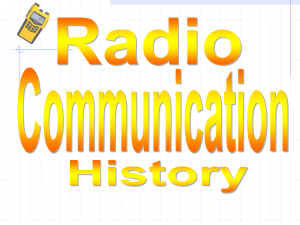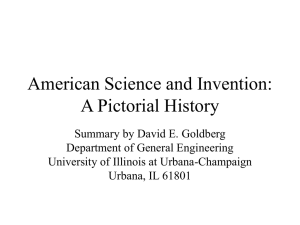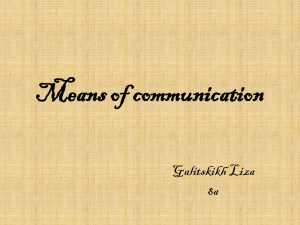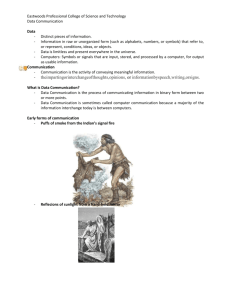An Incomplete History and Timeline of the Electric Telegraph and
advertisement
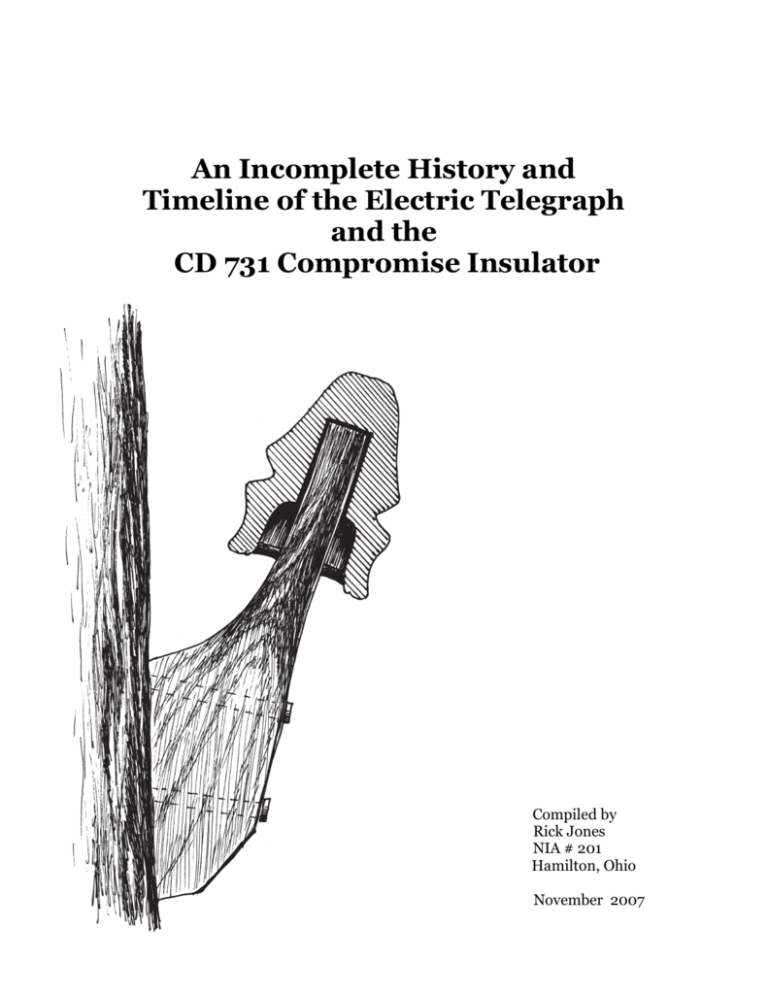
An Incomplete History and Timeline of the Electric Telegraph and the CD 731 Compromise Insulator Compiled by Rick Jones NIA # 201 Hamilton, Ohio November 2007 An Incomplete History of the Electric Telegraph and the CD 731 Compiled by Rick Jones NIA # 201 Hamilton, Ohio November 2007 The purpose of this paper is to bring together a brief historical overview and timeline of the development of the electric telegraph while giving readers a sense of the evolution of the glass insulator. Our journey will culminate with the development of the CD 731 threadless concave skirt “Compromise” insulator. The Compromise style in the U.S.A. actually encompasses CD’s 727 through 732.4 (McDougald Price Guide, 2007). The focus of this paper is the CD 731 since it is the first signal style in the U.S.A. Many researchers feel the concave skirt preceded the straight skirt styles based on early articles in The Telegrapher and other sources. Remember that the Consolidated Design system does not follow any chronological pattern. The electric telegraph grew from advances in electrical science, especially during the first forty years of the 19th Century. The discoveries of galvanic electricity by Luigi Galvani of Italy in the late 1770’s, the electric battery by Alessandro Volta in 1799, research in electromagnetism by Hans Christian Oersted, Andre Marie Ampere, Joseph Henry, and Michael Faraday during the 1820’s and 1830’s all contributed to the discovery of the electric telegraph. These discoveries also propelled the advent of nearly instantaneous long-distance communication. During the 1830’s the American painter and inventor Samuel Finley Breese Morse, developed the recording electric telegraph. His contraption used an electromagnet to record dots and dashes (Morse Code) onto a moving strip of paper. Around 1850, about the time the “egg” glass insulator was developed, telegraph operators began receiving messages by sound listening to the clicks of the electromagnet using what was called a key and sounder. Electric telegraph lines opened in England around 1836. It wasn’t until 1844 that telegraph lines first opened in the U.S. Men thought about such wonders long before technology and innovation permitted these ideas to come to fruition. I begin my incomplete history and timeline with some of those early thoughts and experiments. The timeline begins with Samuel F.B. Morse and his successful bid to create a working electromagnetic recording telegraph. He actually began work on his experiments with the telegraph in 1832, but it was not until 1836 that he had perfected it to the point of being able to present it effectively. Please note that Morse was the first commercially successful inventor of the electric telegraph in America, but many technically successful attempts preceded him. His was not the first telegraph, not the first electromagnetic telegraph, nor even the first recording telegraph, but his was a huge success for his patentees. It also paved the way for a worldwide telegraph phenomenon that ensued for the next decade. But let’s begin with some early creative ideas expressed well before their time and well before Morse and his cohorts. For example, in the Bible, the author of the Book of Job raising this question while thinking the impossible, “Canst thou send lightnings that they may go, and say unto Thee, here we are?” Or, Italian John Baptista Porta in one of his publications in 1575: “To a friend, that is a far distance from us, shut up in prison, we may relate our minds; which I do not doubt may be done by two mariner’s compasses having the alphabet writ upon them.” And finally, what about Charles Marshall of Scotland in 1753 writing in The Scot’s Magazine: “It is well known to all who are conversant in electrical experiments that the electric power may be propagated along a small wire, from one place to another, without being sensibly abated by the length of its progress; let, then, a set of wires equal in number to the letters of the alphabet be extended horizontally between two given places parallel to each other and each of them 1 about an inch distant from that next to it. At every twenty yards’ end let them be fixed in glass or jeweler’s cement at some firm body, both to prevent them from touching the earth, or from another non-electric, and from breaking from their own gravity.” The idea of a working telegraph and the need for insulation has been around since the early 1700’s. The first serious experiments to use a form of electricity were those of the static electricity attempts in Europe around 1726. These failed due to insufficient transmission of high voltages and the weakness of the effects produced. In America (or at that time, the Colonies) in 1748, Benjamin Franklin, like many of the others, was using Leyden jar static electricity in experiments. He strung a wire across the Schuylkill River in Philadelphia at one point and used this method to ignite alcohol flares on both sides simultaneously. It was a crowd pleaser, but not much more. Harrison Gray Dyar of New York in 1828 set up an experimental line around a race track using static electricity produced by friction, bare iron wires and glass insulators of some sort. His message was to be chemically recorded by hand on damp litmus paper. Due to leakage, his experiment failed, and really had no effect on future developments. Similar experiments continued in America as well as Europe for the next 50-plus years. Some of these efforts required as many as 76 wires and proved not only ineffective, but would have been totally impractical to construct had they been successful. This brief timeline and history leaves out an enormous amount of information on the history of the electric telegraph. Please refer to the endnotes for sources if you would like more detailed information. My purpose here is to bring the viewer quickly to the development of the CD 731. Timeline 1837-1865 1837 First telegraph demonstration by Samuel F.B. Morse at the University of New York. This demonstration failed. Observed by Alfred Vail, he made improvements for Morse. Partnership formed among Morse, Leonard Gale (scientist used for title only), and Vail (who invented and who was never credited for, the code and instruments used by Morse). All (along with F.O.J. Smith and Amos Kendall) eventually became the Morse Patentees. 1838 Morse goes to Washington DC to demonstrate his telegraph to President Van Buren and Congress. He asks Congress for $30,000 to construct an experimental line between Washington DC and Baltimore, Maryland -- about 44 miles. He is denied funding. 1839 Englishmen Cooke and Wheatstone develop a working needle telegraph claiming it as an ‘improvement of the electric telegraph’. Both Morse and Cooke/ Wheatstone created improvements on the electric telegraph. The Morse followers claimed for him all originality and priority disregarding decades of earlier development by others -- soon, Morse believed it true as well. This ‘unseemly and excessive pretense’ was carried forward by the descendants of Morse. 1843 Morse continued to experiment and Congress finally passed a bill to appropriate $30,000 to build the line between Washington and Baltimore, thanks to the assistance of Morse’ newest partner, F.O.J. (Fog) Smith. Smith was a Representative from Maine, chair of the Congressional committee observing Morse’s demonstration, and a bit of a scoundrel. President Tyler signs the bill. Ezra Cornell is retained by Smith to lay a lead-encased underground cable and an agreement with the Baltimore and Ohio Railroad is reached to use their right-of-way. By the end of 1843, half of the $30,000 appropriation has been spent on laying this underground cable and it reaches from Baltimore to Relay, MD. Work is suspended when it is discovered that the wire insulation (lead sheathing) was faulty. 2 1844 A new plan to string the wires between wooden poles suspended high above the ground is devised and construction begins that spring. A primary challenge is how to insulate the wires from the poles. Cornell devises a plan to sandwich the wires at each pole between two sheets of plate glass by wrapping the wire in cotton thread, saturating it with a solution of asphaltum, beeswax, rosin and linseed oil. This unit would then be inserted into a notch in the cross-arm. A piece of wood could then be nailed over this glass sandwich and another coat of the solution applied to help hold the “insulator” in place. This is the year of commercial success for the Morse Patentees. Completed on or about May 22, 1844, we are all familiar with the now historic message “What hath God wrought?” sent between Baltimore and Washington on May 24, 1844. Morse sent the message from Washington and Alfred Vail received and sent it back from Baltimore. Did you know that the composer of this message was the daughter of the then head of the U.S. Patent Office and her name was Annie G. Ellsworth? 1845 Continuing struggles with insulation issues led to the creation of the “glass bureau knob” style insulator. This improved insulator was conceived by Cornell and would be used on the proposed New York to Philadelphia line. This line would be constructed under the auspices of the nation’s first private telegraph company -- the Magnetic Telegraph Company. It would be granted incorporation by the Maryland legislature in 1845. This route from Philadelphia to New York had many obstacles, including how to cross the North River to New York City, and challenges slowed progress on construction. Confronting rivers usually meant unsuccessful attempts at underwater cables and the temporary use of messengers or carrier pigeons. Glass bureau knob insulators, of which only a couple are known to be in collector’s hands, are considered the first pin-type insulator (CD 780). 1846 Various glass block type insulators come into use. Widely used into the 1850’s. The Little insulator is developed in England. This glass hat style is large and has a single or double wire groove ridge and an umbrella or saucer-like skirt. Proves very effective at getting water away from the wire. 1847 Ezra Cornell is credited with the adoption of the Little insulator in America. Used extensively in many design variations (CD 734-742.3). A former Cleveland, Ohio portrait artist, Jeptha Wade, began connecting Detroit and Jackson, Michigan with a telegraph line. This project eventually formed the Western Union Telegraph Company in 1856. 1849 First use of the suspended hook insulator. Iron hooks shaped like ram’s horns and set in glass, rubber or paraffin encased in a metal cylinder (typically). These units were attached to poles, cross-arms or wooden blocks. Wire was then suspended along its course hanging from the hooks. Prevalent and used extensively until about 1869. 1850 William M. Swain (formerly editor of The Philadelphia Public Ledger) becomes president of the Magnetic Telegraph Company line between New York and Washington DC, designs what he calls “...the insulator of the future.” Swain designs what becomes referred to as the “egg” insulator (CD 701-701.8). People claimed it to be stronger and more durable and dependable than the umbrella style hats. However, the area below the wire groove on these had a tendency to crack during extended service. Newsmen like Swain had great interest in 3 the success of the telegraph and invested in them as well as became engaged in aspects of its progress. 1855 Amasa Stone of Philadelphia, PA (not the Cleveland railroad tycoon) receives a patent on August 7 for a threaded pin cavity for glass insulators (Patent No. 13,402), preceding Cauvet’s patent by ten years. Stone dies before he is able to apply his invention. Stone’s patent shows only two threads and is for use on a similarly threaded iron pin. The insulator would have required only a half or two-thirds turn and the result may have been only slightly better in service than a threadless application. (August 7, 1855 -- please see patent diagram in display). 1860 During the late 1850’s and well into the early 1860’s, now captain of industry, Jeptha Wade, designs and produces the wood-covered Wade insulator. Ideal for prairie and wilderness applications because the glass insert is protected. However, used extensively on lines from coast to coast. Smaller styles are used in Canada (CD 721-725). Smaller hat styles are developed for ease of transport into wilderness areas and may have incidentally improved insulation by their reduction in size. These will continue to be produced into the mid 1870’s (CD 734-735.3). 1861 The Pacific Telegraph Act of 1860 called for the facilitation of communication between the east and west coasts of the United States of America. Hiram Sibley of the Western Union Telegraph Company won the contract. In 1861, Benjamin Franklin Ficklin joined Hiram Sibley in helping to form the Pacific Telegraph Company of Nebraska. At the same time, Jeptha Wade was asked by Hiram Sibley to consolidate smaller telegraph companies in California. While the Pacific Telegraph Company built west from Omaha, Nebraska, the Overland Telegraph Company of California was thus formed and built east from Carson City, Nevada. With their connection in Salt Lake City, Utah on October 24, 1861, the final link between the east and west coasts of the United States of America was made by telegraph. The First Transcontinental Telegraph led to the immediate demise of the eighteen month old Pony Express. The Pacific telegraph Company and Overland Telegraph Company of California were eventually absorbed into the Western Union Telegraph Company. 1865 This historical timeline ends with the creation of the “Compromise” style glass insulator. General Superintendent of the U.S. Telegraph Company, Merritt L. Wood, is credited with the design of what is now known as the CD 731. It is a cross between two popular designs -- the egg and the umbrella (or hat) styles. The 731 comes sometime just after the concave skirt egg CD 701.8 also called the “National Road Egg” since it has been found only along the route (now U.S. Route 40) of that original wagon road that stretched east and west across Maryland, Pennsylvania, West Virginia, Ohio, Indiana, and Illinois. Also in 1865, Louis A. Cauvet forever changes the future of pin-type insulator design with the invention of the threaded pinhole. Cauvet’s patent is for a fully threaded pinhole requiring the insulator to be turned several times to be fully secured on a threaded pin. It is likely Cauvet was aware of Stone’s 1855 patent and made improvements upon it allowing for a new patent. Cauvet’s patent date shows up on many threaded and at least two threadless insulator styles (July 25, 1865 -- please see patent diagram in display). An interesting crossover appears about this time: the CD 731 and the threaded version, CD 131. One speculates that re-worked threadless molds could have easily become what we now call CD 131. Molds with no embossing could have been engraved with the Brookfield and the more scarce Tillotson name and then a threaded plunger would update the insulator -- all done to extend mold life and reduce production costs. At least one known 131 is unembossed. We now know there are four different 731 embossings (Brookfield, Tillotson, S.McKee & Co. 4 and the “M”) and at least 13 different embossings on the 131. Of course, more could be discovered. Threadless production continued into the mid-1870’s probably due to the expense of production changeovers. A Journey Imagine that the date is now 1867 and you’re going on a walk along the Union Pacific Railroad in southeastern Wyoming. It’s a clear, dry, and almost hot June afternoon with a slight breeze occasionally whipping up a tiny whirlwind near the railroad bed. Blooming spring flowers in purple and yellow sparsely dot the landscape. Only three hundred yards from the tracks, coming out of a rolling swale, are a dozen Pronghorn antelope every once in awhile looking up sharply and rotating their large ears toward you. You freeze, and they continue to graze, flicking deer flies off their ears and tails satisfied that you’re not a threat. Having left your horse tied in the sparse shade of a bristlecone pine tree, you begin your slow walk again along the tracks looking up at the azure, cloudless sky. Piercing rays from the bright sun are shining through a glass object on one of the telegraph poles on the south edge of the right-of-way. It has a wire attached to it. You take out your spyglass and have a look, careful not to catch the rays directly. It’s kind of a small, hat-shaped glass object. The color appears to be a light, powdery blue. You stretch your spyglass and zoom in a little adjusting the focus. There’s writing on the side of the glass. Looks like “M-u-l-f-o-r-d & B-i-d-d-l-e”. You walk a little to your right. There’s something else written on the back. Looks like “U-P-R-R”. Not sure about Mulford & Biddle, but UPRR must stand for Union Pacific Railroad, you ponder. You glance across the tracks just as a Western lizard scurries for cover in a crevice in one of the ties. There are poles on the north side of the track, too. You see another glass object, this time glowing with the sun behind you now. The color is a little more greenish than the other one, like the bottle your daddy’s liver medicine comes in. The shape is also different. It looks larger, has a bit of an angled top, sort of flat on top, with a groove around the middle -- similar to the other one -- and kind of a skirt with sides that curve in below that groove. You raise the spyglass. No writing on this one. Wait. There is something as you walk around to the side. Looks like a different kind of lettering. Not really a script, but certainly not like the one on the other side of the tracks. Looks like “S.-M-c-K-e-e-&-Co.” You don’t know what that means either. Maybe a man’s name, or the name of some company. You amble on down toward the next pole to see what’s on that one. As you walk, you wonder what these things are for. Maybe they insulate the telegraph wire for some reason. Wonder if they call them insulators? Probably not. Must be connectors or some other name. You get to the next pole and find another glass object very similar to the last one. Same shape. Color is different. Looks like a dark green color. The spyglass reveals no lettering at all on this one. Wonder why? Oh well, you pick up a good size rock and look intently at this tempting glass target perched way up there. Seems to be asking you -- taunting you -- to try and hit it. But, for some reason, after staring at the beautiful glass glistening in the hot sun, you drop the rock and move on. You’ve got a stray steer out here somewhere and your horse is getting thirsty. Back to 2007 The above stroll along the UPRR may have been what you could have encountered on many lines throughout the West for several years just after the Civil War. Millions of 731’s (and 735’s) were in use all over the western states. 731’s were throughout the central and eastern states as well. The S. McKee’s were used extensively on the Transcontinental line (along with the unembossed 731’s) and one was even recently found in Indiana still lying on top of the ground next to a set of tracks. The arc embossed Tillotsons were heavily used in the northeastern states and on up into Canada. Maine 5 has turned up a number of these. The beautiful sapphire blue Tillotson 731 has turned up on at least two occasions on the east coast, one fairly recently. The northeast was also the site of discovery of a mustard-olive-amber unembossed 731 about six years ago. Wish I had one of either of these in my display to show you… Much of what is known or assumed about 731’s is speculation, though some researchers who collect threadless have connected some of the dots. For example, long a mystery, it is now fairly well established that the 731 with the “M” or “W” on the dome top is most likely an “M” referencing “Modes” and the maker was probably Beaver Falls Glassworks in Beaver Falls, PA. William Modes was their founder. The glass quality is very similar to that found in other Beaver Falls products (especially the CD 132.2 Paisleys) and the insulator has a fuller dome and is bulkier in general than other 731’s. Embossed 731’s discovered to date include Brookfield, Tillotson, S.McKee & Co., and the “M” dome embossed style. Who knows what may turn up in the future as we treasure hunters keep looking. What about a base embossed Pat’d 731? Bogus? (or, Compromise vs. Compromised) The 731 concave skirt signal long called the “Compromise” style must have been a fairly durable design just as M. L. Wood had predicted. They were produced in huge quantities for many years. And with over 220,000 miles of telegraph lines around the country, the market was booming by the late 1860’s. Today, there are many in collections that look brand new. Many in my display look like they came right out of the barrel of sawdust. Maybe this was a factor that has led some with minimal or no scruples to most likely reproduce the 731. It certainly was not the value since current prices on aquas and blues on unembossed styles range in the $150-$200 (VNM) category. Nevertheless, we have seen questionable 731’s enter the hobby periodically. A large group of different threadless CD’s (including 731’s) and some known CD’s and some not, surfaced in Florida several years ago. All were fairly good copies, but in unusual colors and therefore raising immediate red flags among collectors. As with many reproductions, the glass color and quality tended to give away their recent manufacture, as did CD’s like 719... More recently, a 731 with a narrow dome and the typical Tillotson embossed in an arc on the crown entered the hobby. Only it’s not typical. Both “O’s” in Tillotson are noticeably smaller than the other letters. And the glass, usually black or very dark cobalt and probably other dark colors, looks like it was poured yesterday. These have an “art glass” quality about them that is easy to spot if you’ve handled enough old glass. Not sure of the official NIA stance on these, but I’ll personally go on record officially right here -- my humble opinion is that these are recent reproductions. No evidence, of course. Then, most recently, some 731’s have entered the hobby that are raising real concern. They are made so well that long-time threadless collectors and general collectors who have handled thousands of glass insulators have difficulty telling the difference. I am not going into why this is being done (or even if it is being done) anymore than I already have other than to say that the NIA’s unofficial stance on these suspected bogus 731’s is ‘inconclusive’. I can’t say that I blame them. After all, there is no proof that these pieces are bogus. Nobody has been caught in their garage sticking a threadless plunger into molten glass in a 731 mold or having boxes and boxes of these on hand. But compare them side-by-side with known authentic 731’s and you will see a difference -- in shape and glass quality. These recent 731’s do have some characteristics that are consistent and different from all of the known authentic 731’s. These include a very subtle curvature of the upper and lower wire groove ridges. Also, the base of the wire groove has about a quarter-inch flat spot rather than a smooth concave shape or a V-cut shape. Other than these differences, the suspect 731’s are very close to 6 the embossed 731 Tillotson mold style. But glass quality, color, even some black and/or white flecks in the glass and light surface cracks -especially inside the skirt -- give these 731’s even more attributes to make it difficult to determine their authenticity. One of the suspects in my display even has some rust in the wire groove. Of course, this and wire rubs are easily reproduced. My display features four (4) suspected bogus 731’s. Can you spot them? Stop by my sales table and I’ll let you know if your picks are correct. ************************************* Acknowledgments Research on 731’s is a difficult challenge since few, if any, records are available. Their production remains a mystery in terms of who produced them and exactly when. Patent records seem non-existent as well. Hence, my focus on the history leading up to their development. I am constantly searching for any information on 731’s and, of course, for any 731’s. If you have either, feel free to contact me. I’m in the Crown Jewels Directory, an NIA member and a member of ICON. I would like to thank some people whose writings and conversations were very helpful in compiling this ”Incomplete History and Timeline of the Telegraph and the CD 731”. The McDougald’s Insulators: A History of North American Glass Pintype Insulators -- Volume 1 was, as always, a very useful resource. That volume begins with an introduction titled “Glass Insulators -- the Beginnings” by Ray Klingensmith and this is a terrific historical resource. Like the McDougalds, Ray’s contributions to this hobby are enormous, especially his knowledge of threadless. His auction catalogues were a very good resource. Also helpful and insightful were the many conversations about 731’s and the opportunity to trade for or purchase them for the display. Just a few of those always willing to share their knowledge include Doug MacGillvary, Gary Kline, Ray Klingensmith, John McDougald, Graham Barnes, Paul Greaves, Keith Roloson, Ross Baird, and Tom Katonak. A special thanks to Glenn Drummond for some editorial help. Not only have I known some of these guys off and on for 30-plus years, they continue to help and support my efforts in my new hobby specialty by keeping their eyes open for 731’s and that is much appreciated. An article in Crown Jewels was also quite helpful: Klingensmith, Ray. Crown Jewels of the Wire, Threadless Corner. February 1980. Online resources were too numerous to mention in their entirety, but most helpful was this: J. B. Calvert, The Electromagnetic Telegraph, April 7, 2000 (revised May 2004). This paper is in 27 sections with section 11 dedicated to telegraph insulators. It’s a great and detailed history of not only the Morse telegraph, but the House telegraph, the Bain and Vail alphabets, and an extensive bibliography spanning 1842-1999: http://www.du.edu/~jcalvert/tel/morse/morse.htm#C ICON and the NIA website were extremely helpful. Rick Jones Mid-Ohio Show November 2007 7
